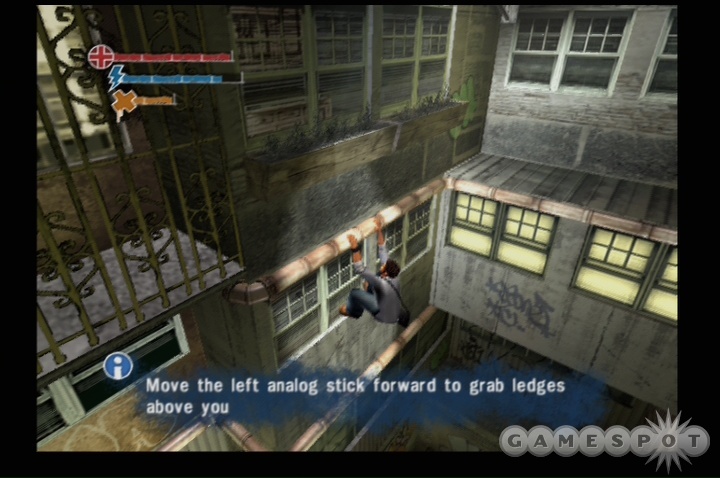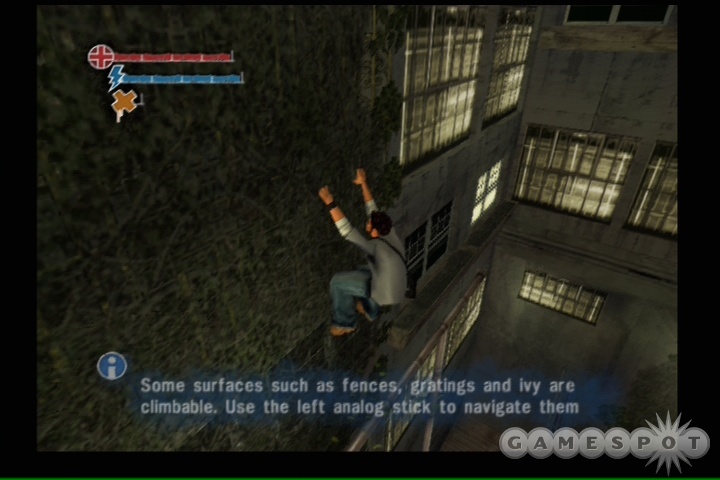Marc Ecko's Getting Up: Contents Under Pressure Preview
We finally got our hands on this stylish action game from Marc Ecko and The Collective. Does it live up to expectations?
It's been nearly two years since Marc Ecko's Getting Up: Contents Under Pressure first appeared on the radar. The game, by Southern California-based developer The Collective, has been advertised as a unique mix of graffiti culture, action adventure, and platforming. Toss in a futuristic setting that's just off the horizon of contemporary society, and you have a game that has the potential to be either something cool and funky, or a spectacular, high-concept disaster. The glimpses we've seen over the past few months have shown a playable game that possesses a fair amount of potential, thanks in part to The Collective's experience at crafting solid action games. Hot on the heels of the announcement proclaiming the game's gold status, we got our hands on a nearly complete version of Getting Up for the PlayStation 2 and the Xbox to find out if (after months of seeing the game and hearing how cool it was going to be) the game has hit the mark.
By now, most folks should be familiar with Getting Up's story, which is set in the near future and follows an up-and-coming graffiti artist named Trane on his journey toward self-discovery and revenge. The tale is more than just Trane's quest to become a master tagger. The bigger adventure that Trane finds himself embroiled in involves the mysterious individuals who have caused the city of New Radius to become the oppressive, graffiti-hatin' place that it is. The tale borrows a bit from God of War and finds you catching up with Trane as he's falling from a tall building (no, he's not committing suicide, but he should have picked a better exit route). The game then jumps back to a period of time before his skydive without a parachute, and you begin to play out the incidents that led him to such a predicament.
The game follows a conventional mission-based structure made up of primary and secondary objectives, most of which revolve around exploration, tagging, and some butt-whupping. The mechanics have improved since we last played, and certain features, such as tagging and your "intuition," have been refined. The tagging mechanic has been simplified a bit from what we originally played--all the elements are still there, but they're implemented more subtly. All you really have to do is use the R trigger (or button, depending on your system of choice) to call up your available tags, the analog stick to set them, and the X button to spray. You'll have to take a break to shake your spray can so as to build up enough of a charge to tag with, which is a nice touch.

Combat has retained the basic elements that we have already heard about--including a combo system and using objects as weapons--but the system doesn't feel quite as robust as that which has been used in The Collective's previous games, such as Buffy the Vampire Slayer or Indiana Jones and the Emperor's Tomb. There are some cool touches, however, such as the ability to perform power attacks and ways to shame your foes with a good old-fashioned slap, which we're hoping gets further built up later in the game. Your progression unlocks features and abilities for Trane to use on his increasingly challenging journey, which feels fairly well paced, although the game's beginning is a little on the slow side. Once the story gets going--you'll find yourself using an abandoned art school as your base of operations--things should pick up.
Getting Up's controls handle like an agreeable hybrid of Prince of Persia and Metal Gear. Trane is an agile dude, and New Radius offers plenty of places for him to explore and tag. In some cases, when you use your intuition, you'll receive secondary objectives, which appear in impossible locations (though we assume you'll gain access, eventually). The intuition view does more than simply let you see objectives. In many cases, it will make you aware of the cone of view from the security cameras that you'll want to avoid while tagging, which ensures that you're not spotted and singled out. Detection, and avoiding it, is an important element to be aware of while playing this game. One nice thing about being so sneaky is that you can get behind enemies and drop them via a paint can to the back of the head. Also, you'll find some complementary touches such as using bolt cutters to let yourself into locales and snapping shots of famous taggers' work to include in your black book (which will help flesh out your own skills).
The visuals in Getting Up have come along nicely since the last time we saw the game in motion. Trane sports a detailed character model that looks good and moves reasonably well. Since he's the central figure, he's one of the best-looking characters you'll see--although the supporting cast comes close to looking just as sharp. The non-player characters and assorted foes you'll face aren't quite as attractive, but they look reasonably good. The city of New Radius, on the other hand, is a funky sight to see, thanks to a design that stitches together elements from various well-known metropolises. The city's biggest influence is obviously New York, as evidenced by the boroughs and subways you'll be able to explore, as well as the cool, layered, claustrophobic feel of some of the areas that let you climb above the streets. The unique design gives many of the areas we've seen a jungle gym feel, which gives a cool sense of scale to what initially appeared to be cramped areas.

As far as the breakdown between the platforms goes, you'll notice the expected, although subtle, differences in sharpness and frame rate. The Xbox version sports a slightly sharper look and a consistent frame rate, whereas the PS2 version isn't quite as sharp and has some minor frame rate hiccups. Thankfully, The Collective's experience with multiplatform development pays off well, ensuring the game looks comparable across both consoles. With that said, there are still a few rough patches that we're hoping will be addressed in the final version, namely the game camera and animation. Though you have control over the camera, we found ourselves adjusting it a bit too often during combat, which, while fine when you're exploring, can be a pain when you're facing multiple enemies. The animation is also a minor issue, since Trane and company don't animate as smoothly as we were hoping (which is a shame, given some of the moves he has).
The audio in the version we played also had its share of highs and lows. On the plus side, there's a wide variety of tunes to play on your in-game iPod once you unlock them. You'll find songs scattered about in mostly obvious places, which you can collect to flesh out your in-game music library. The tracks come from an eclectic range of artists, including modern and retro tunes from Roots Manuva, Del tha Funkee Homosapien, and the ubiquitous Bloc Party, as well as Kasabian, Glen Brown with King Tubby, and Nina Simone, to name just a few.

The game's voice acting is where things aren't as buttoned up as we would have liked. On the one hand, the rather lengthy list of celebs tapped to bring the characters to life is impressive. You'll hear Sean "P. Diddy" Combs, Rosario Dawson, Brittany Murphy, George Hamilton, Andy Dick, MC Serch, Adam West, Giovanni Ribisi, and Charlie Murphy. The celebs are anchored by rapper Talib Kweli, who does a good enough job voicing Trane. The overall quality is a bit sketchy, though. The voices are hit or miss in terms of quality, and we've heard a number of sound samples repeat often. As far as the sound effects go, Getting Up features a nice collection of effects that are sharply done and sport some nice little touches, such as the sound of Trane shaking his paint can while tagging.
Based on what we've played so far, Getting Up still maintains the promise that caught our eye months ago. The gameplay is a bit slow going initially and takes a while before it starts moving along. We like the tagging options themselves and how they slowly expand, but we're hoping the combat beefs up to feel more in line with The Collective's previous offerings. The controls are solid and have some nice touches, but they still don't feel as tight as we'd like. The visuals in the game sport a handsome, stylish look, but we wish the audio was a bit tighter. Overall, we'd say that Getting Up has a lot of interesting things going on. As the debut for a potential franchise, there's certainly promise here, and we're curious to see how it all holds up in the final product, which is due early next month. Look for our full review in the coming weeks.
Got a news tip or want to contact us directly? Email news@gamespot.com

Join the conversation